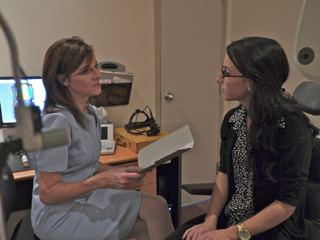What is the Excimer Laser? The excimer laser was developed in 1976 by IBM. It is a computer controlled laser that emits a precisely focused beam of light that can shape the cornea 1/4000th of a millimeter at a time allowing patients to see more clearly without glasses or contact lenses. It is used for Lasik (laser assisted in-situ keratomileusis), and for PRK (photorefractive keratectomy). The laser is currently being performed in over 40 countries including Canada, United States, Germany, Japan, Italy, France and Britain.
How Does it Work? The excimer laser vaporizes the outer layers of the cornea in a precise and controlled fashion. Unlike other lasers, there is no burning or heat generation during the laser procedure. This means that the corneal healing response is minimal (particularly with Lasik) and corneal clarity is maintained.
Does it Hurt? The laser takes only seconds to shape the cornea and it is entirely painless. Only freezing drops are used. With Lasik, irritation is between 3-5 hours with a sensation of burning and tearing.
Is it Safe? The laser has been in widespread use for the treatment of myopia (nearsightedness), hyperopia (farsightedness), and astigmatism for over 20 years. Millions of successful procedures have been performed around the world. Although no procedures is without risks, these risks are minimal, since over 95% of patients are able to drive and work without glasses or contact lenses the day after laser treatment.

What if I Move My Eye During Treatment? In addition to surgeon control, an extremely advanced eye tracker on our laser monitors eye movements and compensates 50 times faster than the eye can move. This safety feature is not present on all lasers.
What are the Long Term Risks? Over the first 18 years that this laser has been performed, there have been no progressive or long term changes that would lead one to believe that there would be any changes in the next 10 to 20 years. However, it is normal for the eye to change in the healing phase immediately after the laser.
Will I become Nearsighted or Farsighted Again? The treatment changes the corneal shape. If your prescription is stable before the laser, it should remain so after the treatment. There may be some regression within the first 6 months after Lasik. This can be retreated and is included in the cost of the initial procedure.
Would an Eye Surgeon Ever Have This Performed? In fact many already have! It is also a procedure that most would recommend to their spouses or friends. This is the best indication of what eye specialists feel about the procedure.
Will I Miss Work? Although the procedure can be arranged almost any day, most people prefer a Thursday or Friday appointment and are able to work on the following Monday. Some can even return to work the next day.
Can Both Eyes be Treated at Once? Most patients will have both eyes treated at once. It is possible to treat one eye at at time for some, and on occasion, only one eye is treated.
What about Follow-Up Care? Local follow-up care is provided to patients treated in Sudbury. For out-of-town patients, follow-up care can be arranged in your city. This is all included in the cost of the laser.
Who performs the procedure? Dr. Sorgini, a Sudbury Ophthalmologist with fellowship training in Montreal in corneal surgeries, is an experienced Lasik and PRK surgeon. He will complete a full eye examination, and he will perform the surgery. He has treated patients from around the world and from all 5 continents.

